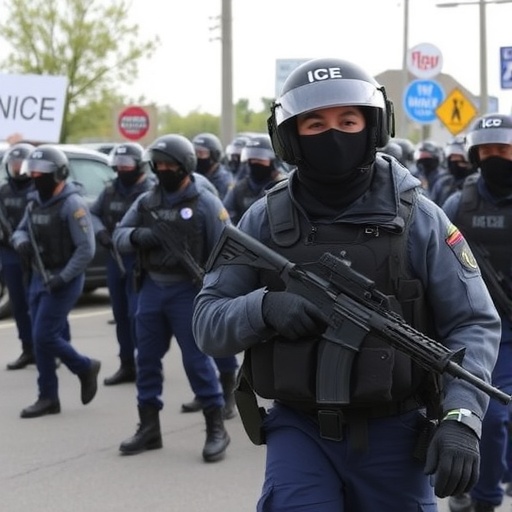ICE Weapons Spending Surges 700% Under Trump: $70 Million Boost Fuels Immigration Raids and Protest Crackdowns
In a dramatic escalation of enforcement tactics, U.S. Immigration and Customs Enforcement (ICE) has ramped up its weapons procurement by a staggering 700% since President Donald Trump’s return to office, pouring over $70 million into an expanded arsenal that includes explosives, chemical agents, and advanced riot control gear. This surge comes amid intensified immigration raids across major cities and a sharp rise in protests against the administration’s hardline policies, raising alarms among civil rights advocates about the potential for widespread violence.
The figures, obtained through Freedom of Information Act requests by watchdog groups, reveal that ICE‘s budget for lethal and non-lethal weapons jumped from approximately $10 million in the final months of the previous administration to more than $80 million in the first quarter of Trump’s second term. Officials attribute the increase to the need for “enhanced operational capabilities” in response to what they describe as surging illegal border crossings and organized resistance to deportation efforts.
“This isn’t just about immigration enforcement anymore—it’s a full-scale militarization of domestic policy,” said Maria Gonzalez, executive director of the American Civil Liberties Union (ACLU) Immigration Rights Project. “With Trump back in the White House, we’re seeing a blueprint for the first term replayed on steroids, complete with weapons that belong on a battlefield, not in American neighborhoods.”
Breaking Down the $70 Million Weapons Windfall
At the heart of ICE’s spending spree is a diversified procurement strategy aimed at bolstering both field operations and crowd control measures. Documents show that $28 million alone has gone toward purchasing high-caliber firearms, including assault rifles and submachine guns, from manufacturers like Sig Sauer and Glock. Another $15 million has been allocated to explosives and breaching tools, such as flash-bang grenades and door-ramming devices, designed to facilitate swift entries during raids on suspected undocumented immigrant hideouts.
Chemical agents, including tear gas canisters and pepper spray projectiles, account for $12 million of the budget, with contracts awarded to companies like Combined Systems, Inc. These munitions have already seen deployment in at least 15 protest incidents since January, according to reports from the Department of Homeland Security (DHS). The remainder of the funds supports logistics, such as armored vehicles and body armor upgrades, ensuring ICE agents are equipped for prolonged engagements.
- Firearms and Ammunition: 35% of the total spend, focusing on 9mm pistols and .223-caliber rifles for tactical teams.
- Explosives and Breaching Gear: 20%, including over 5,000 stun grenades procured in a single bulk order.
- Chemical Munitions: 17%, with stockpiles now exceeding 100,000 units nationwide.
- Protective and Support Equipment: 28%, covering vests, helmets, and transport vehicles.
This breakdown underscores a shift from reactive to proactive armament, with ICE prioritizing tools that can handle both immigration sweeps and potential clashes with demonstrators. Budget analysts note that the 700% increase dwarfs previous years’ allocations, even during peak enforcement periods under Trump’s first term.
Trump’s Immigration Agenda Ignites Nationwide Raids
President Trump’s inauguration in January 2025 marked the immediate revival of his signature immigration crackdown, with executive orders directing ICE to prioritize deportations of over 1 million individuals flagged in a revived “zero-tolerance” database. Within weeks, raids intensified in sanctuary cities like Los Angeles, Chicago, and New York, where federal agents, now heavily armed, conducted dawn operations targeting workplaces, schools, and residential areas.
One high-profile incident in Phoenix saw ICE teams, equipped with the new explosives, storm a meatpacking plant, detaining 250 workers in a single sweep. Eyewitnesses described agents using flash-bangs to disorient suspects, a tactic critics say escalates risks to bystanders. “These aren’t police actions; they’re paramilitary assaults,” remarked immigration attorney Javier Ruiz, who represented several detainees. “Under Trump, immigration enforcement has become a weaponized spectacle.”
Statistics from ICE’s own quarterly report indicate a 450% uptick in raid operations compared to the Biden era, with over 50,000 arrests logged in the first 90 days. This aggressive posture aligns with Trump’s campaign promises to “secure the border like never before,” including plans for mass detentions at expanded facilities along the southern frontier. Yet, the human cost is mounting: families separated, communities terrorized, and legal challenges piling up in federal courts.
The administration defends the escalation, with DHS Secretary Kristjen Nielsen stating in a recent briefing, “Illegal immigration undermines our sovereignty, and ICE has the tools—and now the resources—to enforce the law decisively.” However, border patrol data shows apprehensions have actually dipped slightly, suggesting the raids may be more about political signaling than empirical necessity.
Protests Erupt as Communities Push Back Against ICE Tactics
As immigration raids proliferate, so too have protests, transforming city streets into battlegrounds where ICE’s newly acquired weapons are put to the test. In Denver, a February rally against a local deportation sweep drew 10,000 demonstrators, only to dissolve into chaos when agents deployed tear gas and rubber bullets—items from the fresh $70 million stockpile. Videos of the event, which went viral on social media, captured protesters choking on chemical clouds while chanting “No more walls, no more raids!”
Similar scenes unfolded in Atlanta, where over 200 arrests were made during a sit-in at an ICE detention center. Protesters, including immigrant rights groups like United We Dream, blocked access roads, prompting agents to use pepper spray and batons. “The weapons aren’t just for immigrants; they’re for silencing dissent,” said organizer Aisha Patel. “Trump’s policies are turning America into a police state, one protest at a time.”
Nationwide, protests have surged by 300%, per event-tracking firm Crowd Counting Consortium, with hotspots in Texas and California reporting the most incidents. These demonstrations often intersect with broader social justice movements, amplifying calls for defunding ICE and reforming immigration laws. Legal observers point to a pattern: the more raids occur, the fiercer the resistance, creating a feedback loop that strains law enforcement resources.
ICE’s response has been unyielding, with internal memos leaked to The Intercept revealing training protocols that emphasize “overwhelming force” against gatherings deemed obstructive. This approach has drawn condemnation from international bodies like Amnesty International, which labeled the tactics “disproportionate and escalatory.”
Experts Sound Alarm on Long-Term Ramifications of Militarized Enforcement
As ICE’s weapons arsenal grows, experts are warning of profound consequences for civil liberties, community trust, and even national security. Dr. Elena Vasquez, a policy fellow at the Migration Policy Institute, argues that the 700% spending hike signals a dangerous precedent. “Militarizing immigration under Trump doesn’t solve border issues; it erodes the fabric of democracy,” she told reporters. “We’re arming agents for war against our own people.”
Civil rights litigators anticipate a flood of lawsuits, with the ACLU already filing suits in three states alleging excessive force in raids. One pending case in Miami involves a family separated during a botched operation where breaching explosives damaged a home, injuring two children. “This $70 million is blood money,” Gonzalez added. “It’s funding trauma, not justice.”
Economically, the procurement boom benefits defense contractors but burdens taxpayers. A Government Accountability Office (GAO) preliminary review questions the necessity of such expenditures, noting that ICE’s detention backlog has grown despite the raids, with facilities at 120% capacity. Critics like Sen. Alex Padilla (D-CA) have introduced legislation to cap ICE’s weapons budget, calling it “a wasteful escalation in a broken system.”
Looking ahead, the implications are stark: intensified protests could lead to broader unrest, while unchecked spending might inspire copycat policies in other federal agencies. As Trump pushes for even larger border walls and tech surveillance, immigration enforcement risks becoming a perpetual motion machine of raids, resistance, and rearmament. Advocacy groups are mobilizing for the 2026 midterms, urging voters to demand accountability. Without congressional intervention, the cycle shows no signs of slowing, potentially reshaping America’s approach to immigration for generations.
In the coming months, watch for Supreme Court challenges to these policies and possible whistleblower revelations from within DHS. For now, the streets of America serve as the frontline in this high-stakes drama, where weapons forged in budget lines collide with the raw pulse of protest.










